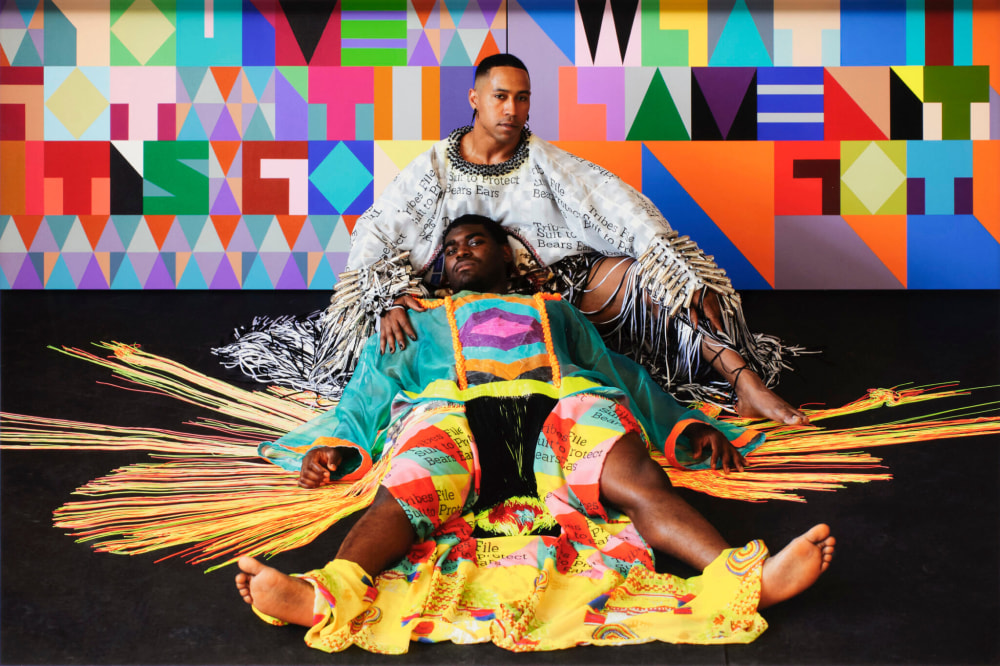

Jeffrey Gibson asks us to co-envision a future and to move toward it. Ceaselessly prioritizing collective imagination as a tool toward manifestation and realization, the artist has stated, “Don’t accept the circumstances you are in; acknowledge that you are in them and then find a future.” Gibson’s form of hard-earned optimism evokes a time frame that unites and collapses past, present, and future into a flowing and responsive mindset, rooted in the belief that a critical engagement with the past can help us shape a brighter horizon.
This major exhibition is devoted to one of today’s foremost artists, whose vibrant interdisciplinary practice combines sculpture and painting, beadwork and video, words and images, incorporating rawhide, tipi poles, sterling silver, wool blankets, jingles, fringe, and sinew—materials that refer to American Indian cultures toward the adornment of quotidian objects such as punching bags, flags, banners, and illuminated signs. Gibson, who is of Mississippi Choctaw and Cherokee heritage, combines aspects of Indigenous art and culture with modernist traditions, navigating and disrupting the expectations placed upon Native artists working within the contemporary art world. At the root of his enterprise lies a core value—objects, and people alike, carry the potential for radical transformation.
Exclusively curated from the collections of Jordan D. Schnitzer and His Family Foundation, They Teach Love presents a sweeping survey of over 35 objects across a span of fifteen years. Beginning with examples of the artist’s earliest engagements with printmaking, our exhibition proceeds to include photography, painting, and sculpture, as well as recent forms that express his foray into performance, installation, and video, as well as contemporary adornment in fashion. The latter direction is reflective of intertribal powwows as well as the dance clubs where Gibson found safe spaces as a teenager.
The exhibition’s centerpiece is an expansive and immersive work titled To Name An Other which is comprised of 51 screen printed elk hide drums and 50 wearable garments. Originally commissioned as a performance by the Smithsonian’s National Portrait Gallery, in 2019, To Name An Other marks a turning point in the artist’s career whereby Gibson has increasingly sought out collective-based projects and performances to activate the communities he works within. This idea is especially appropriate when considering Jeffrey Gibson’s work, as he pushes to create affinity—collaboration is at the heart of his recent social practice. Working and learning together may aid to decolonize our minds and institutions, revealing a future we wish to inhabit.
Organized by the Jordan Schnitzer Museum of Art. Support for this exhibition and related programs has been made possible by a grant from Jordan Schnitzer and The Harold & Arlene Schnitzer CARE Foundation. Additional funding for this exhibition has been provided by the David G. Pollart Center for Arts and Humanities, the WSU Pullman Office of the Chancellor, Nancy Spitzer, the Samuel H. and Patricia W. Smith Endowment, and friends of the museum.
About the Artist
Jeffrey Gibson’s multimedia practice synthesizes the cultural and artistic traditions of his Cherokee and Choctaw heritage with the visual languages of Modernism and themes from contemporary popular and queer culture. His work is a vibrant call for queer and Indigenous empowerment, envisioning a celebration of strength and joy within these communities. Gibson (b. 1972, Colorado Springs, CO) grew up in major urban centers in the United States, Germany, Korea, and England. He received a Bachelor of Fine Arts in painting from the School of the Art Institute of Chicago in 1995 and Master of Arts in painting at the Royal College of Art, London, in 1998. He is a citizen of the Mississippi Band of Choctaw Indians and is of Cherokee heritage. He is currently an artist-in-residence at Bard College and lives and works near Hudson, New York.
Location
The Jordan Schnitzer Museum of Art WSU is located in the Crimson Cube (on Wilson Road across from Martin Stadium and the CUB) on the WSU Pullman campus.
Jeffrey Gibson, Mx Oops and Xavier (The Anthropophagic Effect), 2019